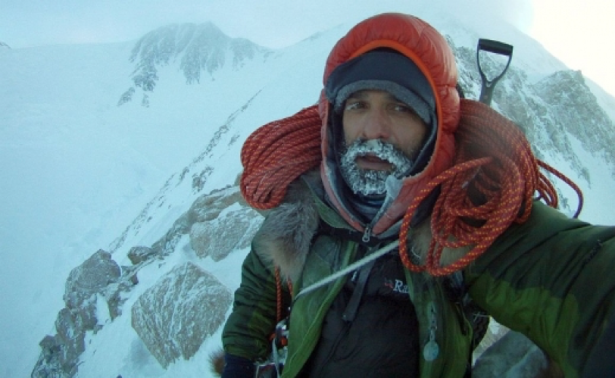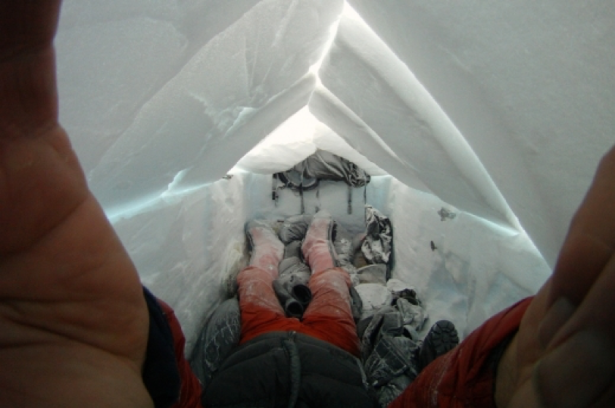Lonnie Dupre Begins Solo Winter Attempt on Denali
Originally posted to the REI blog on 12/30/2011
Lonnie Dupre loves cold weather. Seriously cold weather.
Last week, Lonnie flew from Talkeetna, Alaska, to the Kahiltna glacier on the flanks of Denali (Mount McKinley) where he embarked on a journey that could make him the first solo climber to reach the summit in January.
Denali in winter is not a hospitable place. Only 9 expeditions, totaling 16 people, have ever reached the summit of Denali in winter. Never has a solo climber stood on top of the 20,320-foot peak in January, one of the coldest and darkest months on the mountain. But, that doesn’t faze Lonnie. Remember, he loves cold weather.

Lonnie, 50, learned to enjoy the winter months while growing up on a farm in Minnesota. While others yearned for longer days and warmer weather, Lonnie would spend the winter ice fishing and exploring the woods and creeks around his home at every opportunity.
Shortly after high school, Lonnie loaded up his rundown pickup truck and set out for Alaska, where a 3-week adventure turned into 3 years of working as a commercial fisherman and carpenter to finance trips to the remote reaches of the mountains. By the time he left Alaska, Lonnie was hooked on the Arctic.
For the past 25 years, Lonnie has made it his goal to explore cold places. In a show of Russian and American cooperation as the Cold War drew to a close, Lonnie joined 11 others on a 1,200-mile dogsled and ski expedition from Siberia to Alaska in 1989.
From 1997 to 2001, Lonnie and teammate John Hoelscher traveled 6,500 miles by dogsled and kayak over 3 visits to become the first to circumnavigate Greenland. In 2006, he pulled and paddled modified canoes over 600 miles of shifting sea ice to the North Pole with fellow Arctic explorer Eric Larsen. And, in January 2011, Lonnie made his first attempt at climbing Denali solo in winter.
Just as he will this year, Lonnie began his demanding journey towards the summit 1 year ago on the Kahiltna glacier. Things initially went smoothly, and he made quick work of getting to his high camp at 17,200 feet, where he was poised for a summit bid.
Mother Nature had a different plan though, and Lonnie was forced to sit in a snow cave for 7 days while he battled 100 mph winds and -50 degree Fahrenheit temperatures. With his supplies dwindling and strength diminishing, Lonnie made the difficult decision to descend.

Lonnie doesn’t see his first attempt as a failure but rather a learning opportunity. “Every time you go on an expedition you’ll learn a lot no matter how much preparation you’ve done,” Lonnie said. “Should I take a few more wands? I can’t eat that entrée, should I take something different? You tweak all those things as close as you can get to perfection because your life depends on it.”
This time around, Lonnie will be taking much the same approach as he did on his first attempt, with just a few changes. “I’m going extra light this year,” Lonnie said. “I had everything I needed last year and everything went really well, just the weather didn’t cooperate above 17,000 feet. I’m going with the same kind of method of attack on the mountain except I’m quite a bit lighter this year.”
The biggest weight savings comes in the amount of food he is carrying. Last year, Lonnie carried 2 lbs. of food per day. This year, he’s cut that back to about 1.3 lbs. per day, and when you figure that he’s packing enough food to last him until the first few days of February, that adds up to significant weight savings.
Lonnie will start nearly every day with a hot cup of coffee and a special blend of granola from his local food-coop back in Grand Marais, Minn. Lunch will typically consist of candy bars, dried meat and Pemmican (a mix of meat and cranberries.) For dinner, he will enjoy a Mountain House freeze-dried meal, usually lasagna. He’ll use his trusty MSR DragonFly camp stove to warm his meals and melt snow for water.
Lonnie has also managed to shave some weight off of his mountaineering equipment, bringing his total weight reduction to about 40 lbs., which, as Lonnie notes, “is considerable when you’re dragging stuff up a hill.” While his kit is 40 lbs. lighter than last year, don’t think he doesn’t have a heavy load. At the start of his trip, Lonnie will be carrying a backpack and pulling a sled with a combined weight of 225 lbs. (Editor’s update: We originally reported 125 lbs. which was in error.)
Another way Lonnie chooses to save weight is by not bringing a tent. That’s right, no tent. Each night that he is on the mountain, Lonnie will hunker down in a snow cave constructed with his shovel and snow saw. According to Lonnie, snow caves are “warmer, quieter and safer than tents.”
Constructing a snow cave is no easy task, especially at high altitude. It can take hours to build a snow cave so Lonnie has to be sure to allow enough time and energy at the end of each day. “You don’t want to be completely played out by the time you get to camp because you’ve got 2 hours of digging,” Lonnie said. “Digging at 17,000 feet gets you wheezing for sure. The last thing you want to do is start digging in some hard-packed snow.”
As he did on his first attempt, Lonnie will follow the West Buttress route to a camp at 17,200 feet. For much of the journey, Lonnie will be traveling on custom-made skis that are 7 ft. long and 5 in. wide to help him bridge hidden crevasses.
When the terrain gets too steep, he will cache the skis and travel on foot. From his camp at 17,200 feet, Lonnie will leave the West Buttress route and take a more direct path. “It’s a little steeper, more direct route right up to Zebra Rocks, up to about 19,000 feet,” Lonnie said. “I’ve got about 1,800 feet of a 40 to 55 degree pitch that I’ve got to go up, so the old calves are going to burning by the time I get to the top of that. But, I feel that it’s a safer way to go.”
If you’ve been to Alaska, you know just how much it has to offer outdoor enthusiasts. However, in January, one thing it does not offer a lot of is daylight. Lonnie can expect to see only about 6 hours of light on the day of his summit bid, which means he must rise at 2 a.m. and be moving by 4 a.m. to allow enough time to reach the top and get back down.
“My first 5 to 6 hours of climbing will be in the dark using a headlamp on summit day,” Lonnie said, adding, “That’s because I need as much light as possible on my way down to get back to camp.”
Throughout the years, Lonnie’s Arctic explorations have become about more than just the journey. “I used to do these projects strictly for the adventure part and for personal interest,” Lonnie said. “But over time I’ve really developed a big respect for the environment. So, I want to be able to do something, and I think it’s the responsibility of anybody that does this stuff for a living to bring attention to what’s going on in the Arctic.”
While Lonnie attempts to become the first person to solo Denali in January, he will also be helping conduct scientific research. Through the Adventurers and Scientists for Conservation, Lonnie has been paired up with Dragos Zaharescu, a postdoctoral researcher at the University of Arizona. Lonnie will be collecting small rocks that weigh about 50g each for Dragos and his team of researchers, who will then use the rocks to study how microbial ecosystems interact with primary bedrock on high-altitude landscapes.
The aim of the project is to collect rocks from several mountain ranges across different latitudes, which will allow the researchers to gain information about the evolution of microbe and rock interaction at high altitudes. The project will also let explorers and scientists gain insight into the functioning of such remote environments, which will help in conservation efforts.
Throughout Lonnie’s climb on Denali he will be using a satellite phone and a Sonim cell phone to communicate with and send pictures and videos to his support team in Talkeetna. He will also be carrying a SPOT Satellite GPS Messenger that will send out updates on his position. You can follow Lonnie’s progress on his website, where he will be posting blog entries, photos and videos along the way.
